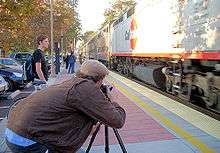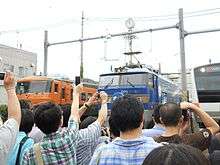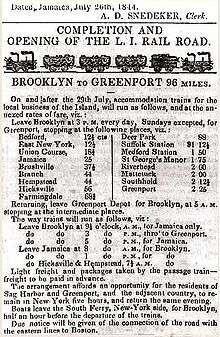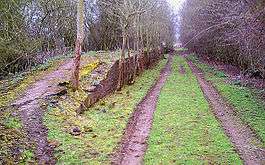Railfan


A railfan, rail buff or train buff (American English), railway enthusiast or railway buff (Australian/British English), trainspotter or anorak (British English), or foamer (pejorative for American railroaders), is a person interested in a recreational capacity in rail transport.[1][2] Railfans of many ages can be found worldwide. Railfans often combine their interest with other hobbies, especially photography and videography, radio scanning, model railroading, studying railroad history and participating in train station and rolling stock preservation efforts. Magazines dedicated to railfanning include Trains and Railfan & Railroad.
Other names
The term metrophile is used by some to identify a railfan with a particular interest in metro (subway, underground) systems. The study of railways, or a general interest in them as a hobby, is sometimes jocularly known as "ferroequinology" (literally, "study of iron horses").
In the UK, railfans are sometimes called trainspotters or anoraks. The term gricer has been used in the UK since at least 1969, and is "Said to have been current in 1938 amongst members of the Manchester Locomotive Society", according to the Oxford English Dictionary. There has been speculation that the term derives from "grouser", one who collects dead grouse after a shoot, but other etymologies have also been suggested.[3] In Northern Ireland and the Republic of Ireland, however, the term Gricer has become increasingly popular within the Railway Enthusiast Community, with Griceling being used for younger enthusiasts.
In Australia, they are sometimes referred to as "gunzels".[4][5] For the avoidance of doubt, the term does not extend to an interest in trams.
Activities

The hobby extends to all aspects of rail transport systems. Railfans may have one or more particular concentrations of interest, such as:
- Railway locomotives and rolling stock
- Still-used or disused railroad lines, bridges, tunnels, stations, and other infrastructure
- Subways and other local rail transit systems
- Railway history
- Railroad photography
- Railway signalling
- Rail transport modelling (traditional, physical) — V-scale modelling
- Collection of railway artifacts, in particular: tickets, timetables, railway paper, number plates, builders' plates, railway crockery. It should be noted that many items such as timetables and railway paper (i.e. internal railway documents) are collected for study and not just as collectibles. There are many retailers and auction houses specializing in such material, both those with street premises and those only on-line.
- Railway art or architecture
- Railway operations, economics or commerce
- Railway preservation/restoration
- Level junction. This is where the railfan can be interested also in the railroad or "grade" crossing signals.
- Monitoring railroad radio communications with a radio scanner.
Indeed, the scope of the subject is so large that fans may additionally concentrate their interest on a particular country, town, operating company, field of operations, or era in history – or a combination of any of the above.
Railway photography


Train photography is a common activity of railfans. Most railfans do their photographing from public property, unless they have permission to use a specific private property owner's land. Occasionally, they run into problems with law enforcement, especially due to post 9/11 paranoia, because they are sometimes viewed as suspicious. In 2004, for example, the New York City Subway attempted to institute a photo ban. This was met with fierce opposition, and was ultimately scrapped.
Some railroad photographers have become well known for their works. Many railfans are familiar with the works of H. Reid, Otto Perry and O.Winston Link; in the UK with Derek Cross (1929–84), John Whitehouse, Maurice W. Earley (1900–82), Rev. Alfred H. Malan (1852–1928), Brian W. Morrison, Ivo Peters, Jim Spurling (1926–Present), H. Gordon Tidey and Rev. Eric Treacy; in New Zealand, with W.W. (Bill) Stewart (1898–1976); or in Germany with Carl Bellingrodt (1897–1971).
In the United Kingdom Photography is allowed at all stations on the National Rail network.[6] London Underground also allows tourists and rail enthusiasts to take pictures and videos while passing through a station, though flash and tripods are not allowed. The Tyne and Wear Metro prohibits all photography without written permission from Nexus, the operators of the system, as of 2015 this is the only system in the UK where such policy is in place.
In Singapore, photography and filming can be taken in all SMRT and SBST stations as long as it does not reproduce for public viewing. However, upskirt photos are illegal and recordings for weddings and movies has to obtain permission from the operators.[7][8]
The Spanish RENFE railroad company also requires an application for a permit.
In Greece railway photography is permitted on all networks[9] but railfans are frequently confronted by security guards.
In Italy, the Royal Decree n°1161 enacted on July 11, 1941, concerning "military secrets," prohibited all and any photographs and video recordings in and around a number of civilian and military installations, including public railways. Railway photography was largely tolerated by tacit agreement, however it could be prosecuted on legal grounds as a felony. The law was repealed by the Legislative Decree n°66 enacted on March 15, 2010.[10][11]
The Union Pacific railroad corporation makes available to its employees and shareholders a full color calendar each year depicting its trains in different parts of the United States where it maintains its rail lines.
In Indonesia, railway photography and filming can be performed in all stations and for all trains, although at times security guards will disallow serious photography using professional cameras or video recorders. Mobile phone cameras, pocket cameras, and entry level handycams, however, are typically allowed, and there is no regulation banning railway photography or filming in stations. For commercial use, a permit must be obtained from the rail office or station's head.
Digital manipulation
 |
 |
| Original (top) and altered image of a 60163 Tornado locomotive |
Digital manipulation of railway photographs is the practice of image editing using graphics software to correct flaws or improve the aesthetics of a photograph of a train. The ethics of the practice are debated amongst railway enthusiasts, as it allows the creation of images that may appear to be other than their actual subjects. Modern features may be removed so that an image of a surviving locomotive hauling a modern special is made indistinguishable from a period photograph.
As well as the usual corrections such as adjusting the brightness or color balance, or cropping to improve the composition, often more drastic photo manipulation is undertaken. This manipulation can involve the removal of items in the image, or changing the livery (paint scheme) or other identifying marks of railway vehicles in the image.
Manipulation is common in the photography of steam locomotives and heritage railways. Photographers often remove anachronistic objects from the scene in order to portray a more authentic setting, or change the liveries of engines or coaches to match historically accurate coaches and locomotives, or simply to suit personal preferences. Steam railway photographers often remove unwanted overhead lines and their pylons, modern lineside equipment or signals. Vehicle liveries are often changed to achieve uniformity for all the coaches in a train (the rake) where dissimilar colour vehicles have been used. In the situations where a railtour operator is able to supply a uniform rake, on longer mainline tours the train will often still include a different colour support coach. Other rakes will contain dissimilar coaches when modern generator cars are required for train heating.
When a diesel locomotive has been attached to the train for operational reasons such as assistance on a bank, shunting, or for generation in the heating role, this is also often removed. The locomotive livery may also be changed to simply demonstrate what a locomotive would look like in an alternative, and possibly extinct or never used, livery. Photographers also often compensate for poor weather conditions at the time of the photograph, for example when the wrong wind direction causes the smoke trail from the locomotive chimney to obscure all or part of the train. Livery changes or scene reinstatement for smoke removal is often achieved through the use of short term rephotography, where the photographer takes two images at the same site and overlays one onto the other.
Trainspotting

Those who are "trainspotters" make an effort to "spot" all of a certain type of rolling stock. This might be a particular class of locomotive, a particular type of carriage or all the rolling stock of a particular company. To this end, they collect and exchange detailed information about the movements of locomotives and other equipment on the railway network, and become very knowledgeable about its operations.
A trainspotter typically uses a data book listing the locomotives or equipment in question, in which locomotives seen are ticked off. In Great Britain, this aspect of the hobby was given a major impetus by the publication from 1942 onward of the Ian Allan "ABC" series of booklets, whose publication began in response to public requests for information about the rolling stock of Southern Railways.[12] Sometimes, trainspotters also have cameras, but railway photography is mostly linked to railfans. Moreover, in contrast to modern railway companies' attitudes, at its inception in 1948 British Railways handed out free copies of a locomotive data book to school-children.
Some trainspotters now use a tape recorder instead of a notebook. In modern times, mobile phones and/or pagers are used to communicate with others in the hobby, while various internet mailing lists and web sites aid information exchange. Railbuffs can maintain private computerised databases of spotting records as well. Radio scanners are common equipment for listening to railroad frequencies in the US to follow rail traffic.
It is a misconception that all railfans are trainspotters. Many enthusiasts simply enjoy reading about or travelling on trains, or enjoying their rich history—this may extend to art, architecture, the operation of railroads, or simply modelling, drawing or photographing them.
Basher
The term "bashing" is used by railway enthusiasts to mean several different things.
- "Bashing" used on its own is a general term for a railway enthusiast's trip, excursion or holiday involving train travel and observation.
- "Line bashing" is more focused, and would be an attempt to cover as much of a railway network as possible. This can also be called "track bashing" especially if the person wishes to try to cover individual sections of track such as crossovers and sidings, in addition to completing an "A to B" journey on each section of line. In the UK (especially), Germany, and to a lesser extent in other countries, railfans often use a special excursion train for railfans (usually known as a "railtour") to cover freight-only railway lines in order to complete their coverage of a country's rail network.
- "Shed Bashing" is a term used by train spotters to describe going out to as many railway sheds (or depots) as possible. These were very popular in the 1950s and 1960s. As they required a permit and this could be hard to obtain some 'Shed Bashers' were illegal.[13]
- Another development from trainspotting (almost unique to the UK) is the "haulage basher" or locomotive haulage enthusiast[14] These individuals attempt to ride behind or in the cab (some people do not count the latter as proper "haulage") of as many locomotives as they can, marking them off in a book as would a regular trainspotter. Even the shortest haulage will count, such as being hauled for a few hundred yards by a shunting locomotive when one portion of a train is being hooked up to another at a junction. In some cases fans who like the sound of a particular type of locomotive working hard hauling a train will ride behind them as much as possible, even following English-built locomotives exported abroad, Portugal's 1800 Class (similar to BR Class 50) being one example. "Haulage bashers" sometimes use unusual words and language known as "basherspeak".
Complete riding
Another enthusiast activity is attempting to ride the complete railway network of one or more cities, state, or countries. This may take months or years in the case of dense networks. The definition of 'complete' riding may change from person to person, and non-passenger routes may be included by travelling on special excursion trains, others may attempt to ride on each individual track and curve, rather than the route as a whole, some may not include riding during night, and others may require visiting each station rather than just passing through. British enthusiasts who attempt to cover a railway network are usually referred to as "gricers" or "track bashers".
There are informal competitions for visiting all the stations in a particular network in the shortest time; examples include the Tube Challenge on the London Underground and the Subway Challenge on the New York City Subway.
Collecting railroadiana
Many railfans also collect "railroadiana" or "railwayana". Railroadiana refers to artifacts from railroads and railroad operations and could include nearly anything to do with a particular railroad, including public or employee timetables, locomotive number boards, dining car china, passenger train tickets, tools and pieces of equipment such as lanterns, or sometimes items as big as train horns, or track speeders. Although few can afford the acquisition cost or the space for storage, some railfans collect full size rolling stock or locomotives.
Fantrips
Many railway preservation groups run special trips for railfans using restored trains, often on "rare mileage" locations that do not see regular passenger service.[15] These trips are both social events, as well as an opportunity for railfans to photograph unusual trains. Chasing a fantrip by road for the purposes of photography is often referred to as "Motorcading" in Australia.[16][17]
Exploring abandoned railways

Searching for and exploring abandoned railways is another area of railfan interest. Using old maps, one may find the former route, and the abandoned railway stations, tunnels and bridges may remain after a railway closure. Some abandoned rail rights-of-way have been converted to rail-trails for recreational use such as bicycling, walking, hiking, running or jogging. This would be considered railbanking, where the right-of-way is preserved, by keeping it intact, for the potential reactivation of rail service in the future.
Other activities
Some railfans are interested in other aspects of railroads not directly dealing with the trains. They may be interested in studying the history of the railroad companies, their infrastructure, law, financing and operations, including never-built plans. Abandoned railroad grades can often be found long after the railroad stops using them. Trams (and occasionally even monorails) may also be of interest.
Some enthusiasts combine their interest in trains with the hobby of monitoring radio communications, specializing in listening to radio communications of railroad operations using a scanner.[18]
Various magazines, clubs and museums are designed mainly for railfans, concentrating on the history of trains and railroads. Some clubs organize fantrips, either by car or by train; the New York Transit Museum owns some old equipment with which fantrips are occasionally run on the New York City Subway.
Origins of interest

The motivation for someone developing an interest in railways can come from many sources.[19][20]
Many railfans have a fixation with steam locomotives, which sometimes also fascinate the general public, as seen by the attendance at stations to view steam-hauled railtours. Sometimes the appeal of trains is nostalgic, recalling an earlier era when the railroads played a central role in commerce and transportation, and the depot was the center of every town. Nostalgia may also result from the long, lonesome wail of the train's horn, which mimics vocalizations that want for a more simple time reminiscent of home, as heard in country or folk music worldwide.[21] Sometimes the appeal is due to a fondness for large machinery that can be inspected and photographed up close. Sometimes there is an appeal of the scenery of the railroad running through open, uninviting terrain, or the gritty ambiance of the urban train yard. In this case, urban exploration poses a similar appeal. Some people were raised near streetcar tracks or railways. Everyday activities were associated with railroad, which seemed to be a part of life. This may lead to an interest in railcars, how they move, numbering, and other rail systems in the world and how they compare with their native ones. If these people move to another locale, their interest in railroads might be nostalgic.
Another appeal of the railroads is the business side of railroading. Railroads were long central to economic growth and commerce, and still are to some extent. The history of railroads and railroaders (such as James J. Hill) is a fascination for some, whether they view them in a positive way as capitalist heroes or in a negative way as robber barons.
Safety
Railfans in America have been asked to keep railroad areas safer by reporting crimes and suspicious activity.[22] In the United Kingdom the British Transport Police have asked trainspotters to report any unusual behaviour and activities at stations.[23]
In the United States, concerns about terrorism have led to situations where railfans are followed or confronted by local law enforcement or transit police.[24][25]
The BNSF railway instituted the "Citizens for Rail Security"[26] (CRS) program for the general public to report suspicious activities on their railways. Obtaining this card is common for railfans and is a derivative of the BNSF "On Guard" program for employees. However, this card does not recognize members as employees or contractors, and asks them to keep off railway property. Amtrak offers a similar program, "Partners for Amtrak Safety and Security" (PASS).[27]
Network Rail, the British rail infrastructure owner and station operator, has produced guidelines for the behaviour and responsibilities of railway enthusiasts at its stations.[28] In May 2010, the dangers of acting carelessly in the vicinity of an active railway were highlighted after an enthusiast, standing next to a double track line filming a steam train on the far track, failed to notice an express train approaching at 70 mph on the nearer track in the other direction, and came within inches of being struck by it.[29][30]
Jargon
Railfans have jargon that can be foreign to others:
- Glossary of North American railway terms
- Glossary of Australian railway terms
- Glossary of United Kingdom railway terms
- Glossary of New Zealand railway terms
See also
- List of notable railfans
- List of railroad-related periodicals
- Rail terminology
- Rail transport modelling
- RR (2008 railfan film by James Benning)
- Sensible Train Spotting, the world's first computer train spotting simulator
- Indian Railways Fan Club
- Train whistle
Similar hobbies
Notes
- ↑ Larson, Russ (1974). "Learn the lingo". N Scale Primer (Fourth printing, 1977 ed.). Milwaukee, WI: Kalmbach Publishing. p. 101.
- ↑ Kisor, p. 5.
- ↑ "Gricer, n.". Oxford English Dictionary. Retrieved 5 March 2015.
- ↑ Campbell, Don (2004-01-02). "Gunzels". Trams Down Under. Tramway Museum Society of Victoria. Archived from the original on September 5, 2007. Retrieved 2007-10-05.
- ↑ Moynihan, Stephen (October 1, 2007). "Rail fans celebrate own win as new line launched". The Age. Retrieved 2007-10-05.
- ↑ "Railway enthusiasts". Network Rail. Retrieved 2015-09-25.
- ↑ "Require Permission to Trainspot". Forums.sgtrains.com. Retrieved 2012-03-15.
- ↑ "Emergency Do Not Upload Train Media Without Written Permission". Sgforums.com. Retrieved 2012-03-15.
- ↑ "Legal case" (PDF).
- ↑ "Regio Decreto 11 luglio 1941, n. 1161. - Norme relative al segreto militare." (PDF). www.meniero.it/. 2013-04-12.
- ↑ "Decreto Legislativo 15 marzo 2010, n. 66" (PDF). www.difesa.it/.
- ↑ Interview with Ian Allan as part of the Last Days of Steam broadcast as part of the Timeshift series, BBC Four, 5 April 2012
- ↑ Railway Top Spots: Revisiting the Top Train Spotting Destinations of Our Childhood - by Julian Holland
- ↑ Carter, Gary. "Everything You Need To Know About "Bashing"". (A Beginner's Guide). Dreadful.org.uk. Retrieved 2007-03-27.
- ↑ "Rare Mileage". American Heritage. Retrieved 2007-10-29.
- ↑ "Australian Railway Slang". Home.alphalink.com.au. Retrieved 2012-03-15.
- ↑ "Hotham Valley Railway". Hotham Valley Railway. Retrieved 2012-03-15.
- ↑ Tom Kneitel, K2AES (1990) [1982]. Rail-Scan: Directory of railroad scanner frequencies. New York: CRB Research Books, Inc. pp. 5–6. ISBN 0-939780-12-7.
- ↑ "Enthusiasts" in Simmons, J. and Biddle, G. (eds) "The Oxford Companion to British Railway History". Oxford University Press, 1997.
- ↑ Richards, J. and McKenzie, J.M. "The Railway Station: A Social History". Oxford University Press, 1986, pp. 13-14.
- ↑ Fox, Aaron A. (2004-10-04). "Real Country: Music and Language in Working-Class Culture". Duke University Press Books. Retrieved 2013-10-12Cited by Radiolab. Season 4, Episode 5, 39:00.
- ↑ "BNSF Railway Asks Rail Fans for Cooperation To Keep America's Rail System Safe". BNSF Railway. June 7, 2006. Retrieved 2008-02-04.
- ↑ "British Transport Police advice to Rail Enthusiasts". Btp.police.uk. Retrieved 2014-08-13.
- ↑ Ripley, Amanda (May 16, 2004). "Hobbyist or Terrorist?". time.com.
- ↑ Phillips, Don (November 17, 2002). "`Railfans' Love Trains, But They Draw Stares From Cops After 9-11". orlandosentinel.com.
- ↑ http://www.citizensforrailsecurity.com/
- ↑ "Partners for Amtrak Safety and Security website". police.amtrak.com. Retrieved 2014-09-25.
- ↑ "Railway enthusiasts". Network Rail. Retrieved 2012-03-15.
- ↑ "Train spotter in narrow escape". BBC News. May 14, 2010. Retrieved 2010-05-14.
- ↑ "Railway buff filming in Suffolk fails to see express". BBC News. May 14, 2010. Retrieved 2010-05-14.
References
- Kisor, Henry (1994). Zephyr: Tracking a Dream Across America. Holbrook, Massachusetts: Adams Publishing. ISBN 1-55850-477-X.
- Heritage Railway. No. 122. March–April 2009. Missing or empty
|title=(help)
Further reading
- Adams, Will (2006). Trainspotting Days. Kettering: Silver Link Publishing. ISBN 1-85794-267-1.
- Carter, Ian (2008). British Railway Enthusiasm. Manchester: Manchester University Press. ISBN 978-0-7190-6566-8.
- Harvey, Michael G. (2004). Forget the Anorak: what trainspotting was really like. Stroud: Sutton Publishing. ISBN 0-7509-3402-6.
- Harvie, Christopher (1992). "The English railway enthusiast". In Diller, Hans-Jürgen (ed.). Englishness. Heidelberg: Carl Winter. pp. 107–22. ISBN 3-533-04536-6.
- Marchant, Ian (2003). Parallel lines: or, Journeys on the Railway of Dreams. London: Bloomsbury. ISBN 0-7475-6578-3.
- Marsden, Colin J. (2010). Rail Guide 2010. Shepperton: Ian Allan. ISBN 978-0-7110-3457-0.
- Mathison, Phil (2006). Shed Bashing with the Beatles. Newport, Yorkshire: Dead Good Publications. ISBN 0-9546937-3-6.
- Packer, David (2003). Well Trained. Leigh: Triangle Publishing. ISBN 0-9529333-8-1.
- Whittaker, Nicholas (1995). Platform Souls: The Trainspotter as Twentieth Century Hero. London: Gollancz. ISBN 0-575-05981-8.
- Gray, Adrian (February 1986). "Rail Enthusiast No. 1". Rail Enthusiast. No. 53. EMAP National Publications. p. 43. ISSN 0262-561X. OCLC 49957965.
External links
| Wikivoyage has a travel guide for Travel for rail enthusiasts. |
| Wikimedia Commons has media related to Trainspotting. |